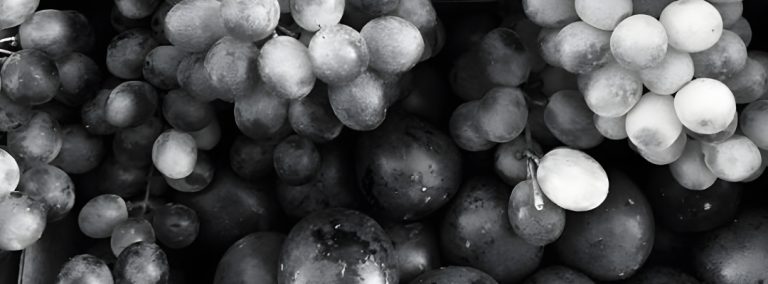Wine glasses come in a variety of shapes and sizes. They can have a large bowl in the case of some red wine glasses or a small bowl as in a lot of the glassware for white wines. Some glasses are narrow at the rim and in others the design includes quite a broad, wide opening. They can be vertical like a Champagne flute, round like a tennis ball with a thin stem, or even stemless. So what’s the difference and how many types of wine glasses does the average household really need?
The shape of a wine glass influences how much direct exposure to air the wine gets. The size of the opening at the rim also helps you pick up on the aromas in the wine and determines how the wine hits your mouth and spreads across your tongue. This in turn affects your sense of taste and ability to perceive nuances in flavor. While having the right glass is often more important for red wine, you’ll still find a white wine, a rosé, or a sparkling wine will taste different depending on the glass you drink it out of.
This is because wines have different properties according to the grapes that go into them and how they are made. If you’re not that into wine and just want to make sure you have something on hand for special occasions, you can get universal red and white wine glasses – the glasses for red tend to be a bit bigger than for white.
However, if you drink wine fairly regularly and want to experience and learn more about the wines you’re bringing home, you may consider investing in a few different glass shapes. Glasses exist for almost every type of wine, but you don’t have to get them all. A Pinot Noir and a Cabernet glass will do perfectly fine for most red wines and a Sauvignon Blanc and an oaked Chardonnay glass can cover you when it comes to white wines. You then just need some Champagne glasses for when you next open a bottle of bubbly!
You can learn more about each of these glass types in the sections below.
Different glasses for different wines
Wines can be light to medium in body, medium to full-bodied, aged in oak or unoaked, and with or without bubbles. Some are higher in acidity, others have lower acidity but are fuller in flavor with more texture. For almost every type of wine, there is a particular type of glass that will help you best appreciate the wine’s aromas and texture, and enhance its flavor. Nonetheless, there are some glass types that are more versatile than others. Here are two basic red glasses and two basic white wine glass types we recommend, and the different types of wine you can drink out of them.

1. Pinot Noir / Burgundy glass
Pinot Noir is a light to medium-bodied red wine with high acidity and bright fruit flavors. In Pinot Noir glasses, the opening or rim is smaller and the glass has a large bowl that narrows as it gets to the top. There’s a good amount of surface area inside the bowl and when you take a sip, the wine is funneled toward the center of your mouth. You want this effect because you’re trying to focus the wine on the area of your tongue where you’re best able to pick up on sweetness and fruit. This helps to create balance in what you are tasting and to enhance the wine’s aromas and natural flavor profile. Some glasses will be rounder and others will have a tulip shaped lip. Note, you’ll also find these labeled Burgundy glasses because most of the red wines from Burgundy are Pinot Noir.
Other wines you can drink out of this glass: Beaujolais and any red made from the Gamay grape, Nebbiolo-based reds like Barolo, Barbaresco, and Barbera, red Southern Rhône wines like Châteauneuf-du-Pape that are Grenache and Mourvèdre based
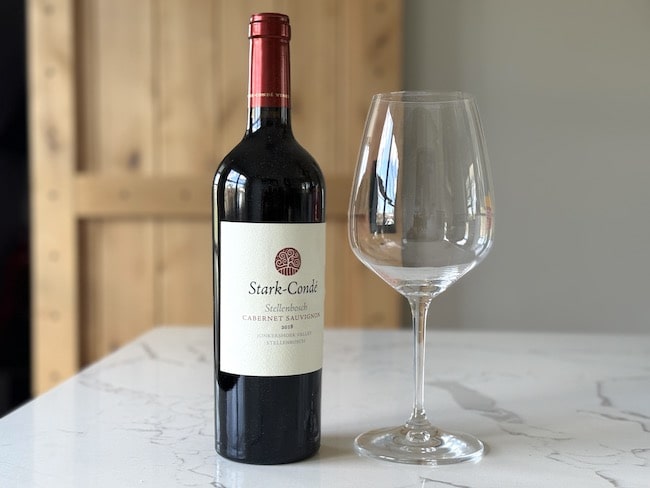
2. Cabernet / Merlot / Bordeaux glass
For a red wine like Cabernet, you want a glass with a wider opening that helps to spread the wine across your tongue and around your mouth. You need it to reach the sides of your mouth, where you’re best able to taste acidity. A Cabernet glass is quite broad but doesn’t have as much roundness to its bowl and isn’t tapered or flared like Burgundy glasses. It’s more straight up and down. It also has good surface area to give the wine space to breath and aerate. This is because Cabernet is a wine with a lot of tannins and rich, layered fruit. It needs exposure to oxygen so the aromas in the wine can be released, the tannins can soften and the flavors can harmonize.
A Cabernet glass more closely resembles the universal red wine glass types you’ll find in some stores and is also called a Cabernet / Merlot / Bordeaux glass. This is because Merlot and Cabernet are two of the major grapes in Bordeaux blends!
Other wines you can drink out of this glass: Merlot, Malbec, Bordeaux Blends, Syrah / red Northern Rhône wines / Shiraz, Chianti Classico, Brunello and Sangiovese-based wines, Red Zinfandel, Tempranillo-based Spanish red wines like Rioja and Ribera del Duero

3. Sauvignon Blanc glass
Sauvignon Blanc is a high acid white wine with good tart fruit. Sauvignon Blanc glasses look like smaller versions of Bordeaux glasses. They don’t have a rounded bowl, and are more straight edged and narrow, but with a slightly tapered opening at the top which is better for funneling the wine to the center of your tongue.
You’ll find slight variations and some glasses will be smaller than others, or have a longer stem, but all of them will embody the same basic structure to help you taste the sweetness in the fruit and provide more balance to enhance the wine’s flavors. Note Riesling is another high-acid wine that works well in these glasses – a dry Riesling or a Riesling with more residual sugar. You can also drink most dry Italian white wines out of this type of glass.
Other wines you can drink out of this glass: Pinot Grigio / Gris, Gavi di Gavi, Verdicchio, Soave, Chenin Blanc, Chablis, high acid Spanish white wines like Albariño or Verdejo, Rosé
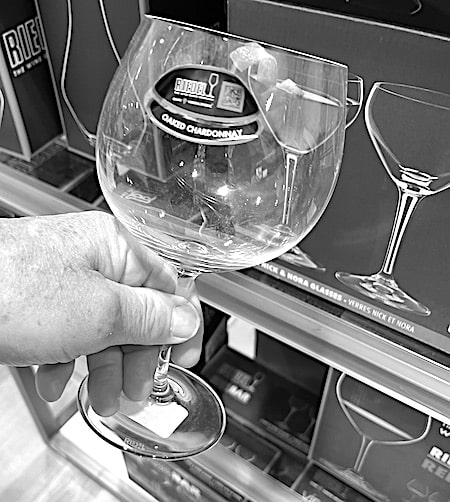
4. Oaked Chardonnay glass
Chardonnay is a white wine that comes in different styles. Whereas an unoaked wine is best served in a Sauvignon Blanc glass, an oak aged Chardonnay is often richer with less direct fruit flavors and more texture. Consequently, you need to drink it out of a glass with a bowl better suited to wine with woody notes. An oaked Chardonnay glass is quite round and its bowl gives the wine decent exposure to air. Exposure to air is like artificial aging for wine that helps release the aromas and enhance its flavors. This glass is also quite wide at the rim, to help spread the wine across your mouth as you take a sip. This is as opposed to focusing it on the center of your tongue.
Note, an oaked Chardonnay glass is also the best glass for wine that has gone through full malolactic fermentation in which the acid has been changed from sharp and citrus driven to a softer, milkier version.
Other wines you can drink out of this glass: White Rhône wines, white wines from Rioja that have had oak aging
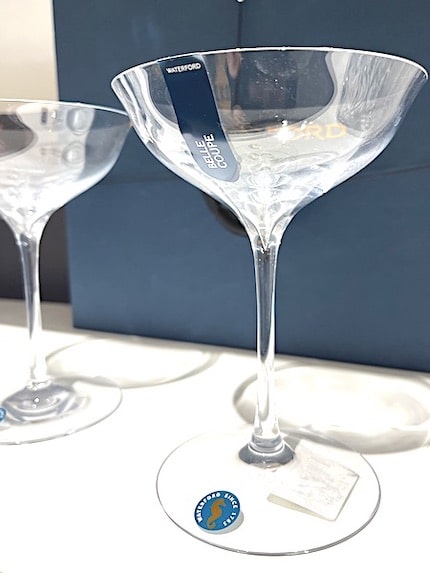
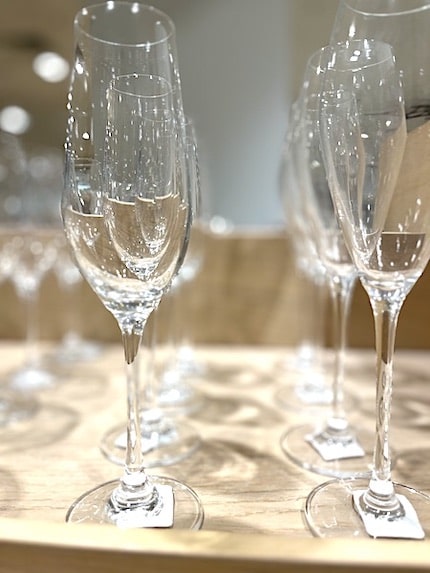
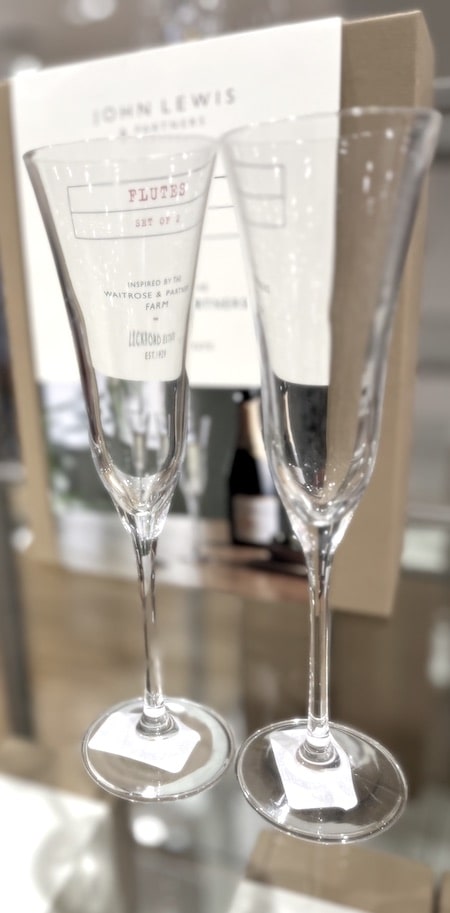

5. Champagne glass
When you picture a Champagne or sparkling wine glass, it’s typically either a long tall flute or a wide flat coupe that comes to mind. The flute is the most common type to have at home. The problem is Champagne is a light and bubbly wine with beautiful aromas and when you have a straight and narrow mouthed flute, you risk not being able to properly smell what’s in your glass.
The wide coupe is a traditional Champagne glass some say was modeled after Marie Antoinette’s breast (though there’s no evidence to back that story up). It’s not necessarily your best option either, as it has so much surface area you can lose the carbonation in the Champagne quite quickly and it’s hard for you to pick up on any one aroma when the shape of the rim isn’t doing anything to help your nose. You can also end up grasping the glass by the bowl if the stem is on the smaller side.
A tulip shaped Champagne flute is actually the best choice for Champagne glassware. It’s wider in the bowl and allows you to experience more of the aromas and flavor in the Champagne.
Champagne Wine Tip: You usually fill a sparkling wine glass 50-60% full. If you don’t have Champagne glasses available, you can always use Sauvignon Blanc glasses.
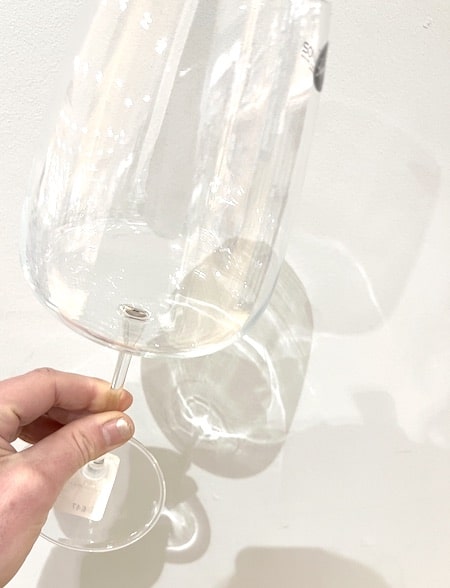
Other glass types you might want to have on hand
If you like wine, particularly certain types of wine, there’s no reason why you shouldn’t invest in a few more glass styles. There are wine glasses made specifically for Syrah / Shiraz. They look like Bordeaux glasses that have been slightly stretched and tapered. They also make Sangiovese / Red Zinfandel glasses, and for white wines, Riesling glasses.
You can get new world Pinot Noir glasses too. A new world Pinot Noir glass has a bit of a lip at the rim and is made for wines from Oregon and California. However, it also happens to be the best glass for Nebbiolo-based wines like Barolo and Barbaresco.
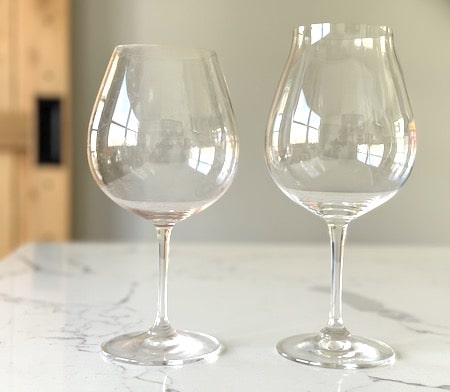
How important is design?
A lot of wine glass makers don’t understand the science behind stemware, they’re more interested in the aesthetic value of the glass i.e. its design and how it looks vs the functionality of its shape. This means you can easily end up with very pretty and unusual looking glasses that don’t do anything to help the wine that’s poured into them. In some cases, glasses with a poor design can even cause you to miss out on the full range of aromas and flavors you should be experiencing with a wine!
Stemless glassware
Where the stem meets the bowl of a glass is its weakest point. Consequently, stemless glassware can help reduce breakage, which is important for restaurants. You may see stemless glassware in a modern restaurant or outside dining settings. Nonetheless, you won’t necessarily have the same experience of the wine. Because you’re forced to hold stemless glasses by the bowl, it’s also possible that you are inadvertently warming your wine. When a wine is too warm it can mute the flavors so you taste more of the alcohol instead of the fruit. This is the case with white as well as red wines. Keep in mind stemless glasses also have less diversity in their shape and form.
Why Riedel makes the best wine glasses
Claus Josef Riedel was one of first glassware producers to realize glass types can dramatically affect your perception and enjoyment of wine. Riedel noticed if you pour the same wine in two different glasses it can taste very different. When he took over his family’s glassware business, Riedel Crystal, in the late 1950s, he began to focus more on form and function than appearance. The first new wine glass Riedel created was a Burgundy Grand Cru. Over the next twenty years he continued to expand the Riedel range, inviting top winemakers of particular wine types to visit his factory and help the Riedel team taste wines in various glass shapes until they found the best form and design for each grape. Riedel created glasses for Sauvignon Blanc, Bordeaux, Chardonnay, and most other popular varietals. If you really wanted to you could probably find a Riedel glass for just about every wine on the market, but be warned it could cost you a pretty penny to take them all home!
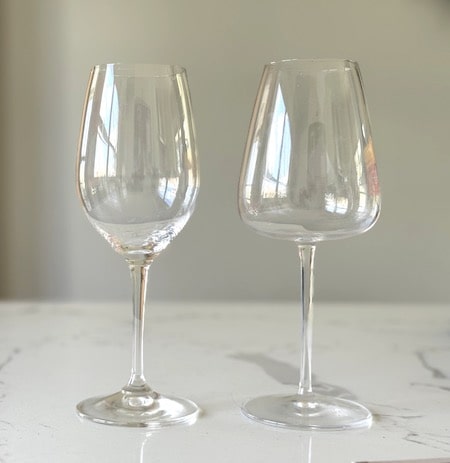
5 Things to consider when you’re buying wine glasses
- How thin is the glass? As a general rule, look for stemware where the glass is thin vs thick. A thin lip on the rim is particularly important because it affects how the wine spills into your mouth.
- How heavy is the glass? Wine glasses can be machine-made or handblown and this will affect how thin they are and in turn, how light they are. Thin, lightweight wine glasses will give you a better experience but will also cost more.
- How large is the glass? You want to make sure wine glasses are actually big enough for you to drink out of them. You never fill a wine glass more than 40-50% so you’ll want a full 12 ounces to be sure you can swirl your wine and experience all of the aromas.
- Does it have the right shape? We’ve mentioned that for certain wines, the size of the bowl and opening are important. If the shape of the glass you’re considering buying is somewhat formeless, it may be a sign that you really have water glasses mislabeled as wine glasses. Be wary of no curvature to the bowl and an excessively wide top as this type of glass won’t do anything to enhance the wine’s flavor.
- Is it labeled correctly? It’s not uncommon to see wine glasses mislabeled. We’ve given you a brief guide in this article but when in doubt do a quick Google search and make sure the shape and design types you see on your phone match what’s been put on the box label.
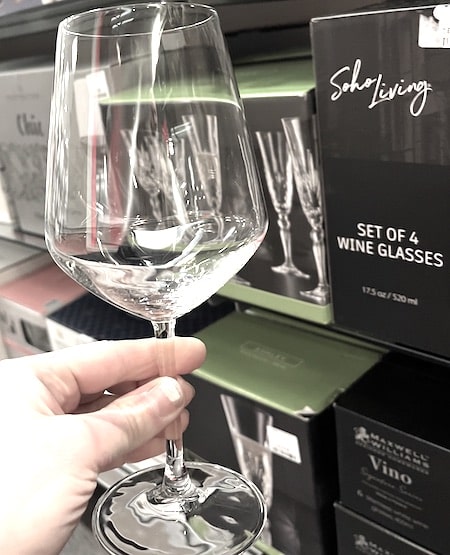
How much should you spend?
Wine glasses can range significantly in price and quality but you can usually find a decent pair for anywhere from $30 to $60. The higher up in quality you go, the more you’ll pay. This is even true for Riedel where there are different levels of glassware for different budgets. If you’re just looking for universal red and white wine glasses, most home good stores should have what you need. Otherwise, you may want to visit a specialty wine glass and restaurant store or try a higher end department store where they’ll likely carry Riedel, Spiegelau, Zalto or Josephine and have a greater range of glass types in stock.
More questions and answers about wine glasses
Which glasses should you drink rosé out of?
Rosé is a wine that sits somewhere in between red and white in terms of body and flavor. However, when it comes to glassware you should use white wine glasses. That’s because rosé tends to be higher in acidity, though this does depend to some extent on the rosé. In most cases, a Sauvignon Blanc glass is the preferred glass. If it’s a high acid wine, you can also use a Riesling glass.
Is there anything special about crystal stemware?
Other than price and exclusivity, glasses made out of crystal aren’t necessarily better than regular wine glasses. In fact, a crystal glass can even prevent you from experiencing some of the flavors in a good bottle of wine if it’s too thick or the design is visually pleasing but not developed in line with best practices for the type of wine you are having.
Does the age of the wine make a difference?
You don’t need to worry so much about having the right glasses for everyday drinking wines that you open quite young. In fact, many bistros in Europe still serve wine in small, uniform glasses. This is because the wine is simply there to accompany the food. It’s not the best quality to begin with and the restaurant knows it won’t change much about your experience if the wine is poured in a different glass.
Is the size of the glass base important?
The size of a wine glass’s base affects the stability of the glass itself. Smaller glasses tend to have smaller bases. If you find you’re a bit clumsy, look for a bigger base, or go with stemless glassware where the base of the bowl is the base of the glass.
Do’s and Don’ts of cleaning wine glasses
- Do wash your wine glasses by hand. Hold the glasses by the bowl and not the stem when you’re actually washing them. Use a light soap vs a heavy detergent and keep a sponge you only use on your wine glasses so you don’t transfer any food elements like oil or bacteria to them. Be sure to rinse glasses thoroughly in hot water. The hotter the water, the less it will cling to the glass.
- Don’t put nice glassware in the dishwasher. In a dishwasher you can have soapy residue that coats the inside of the glass and can be hard to remove. You’ll also find more delicate stemware will break, which is a shame, especially if you’ve spent a fair amount of money on a new set of Riedel glasses.
- Do dry your glasses on a drying rack or paper towel. The best way to dry wine glasses is on a drying rack or upside down on a clean piece of paper towel. Shake the glasses first to get as much water out as you can.
- Don’t put wine glasses upside down on a dish towel. As the glasses dry and the water evaporates, they will absorb the soap vapors from the laundry detergent used to wash the towel and these will then coat the inside of the bowl. You may not see this process happening, but you’ll notice it the next time you pour a glass of wine. It can affect the flavor and aromas you can smell in a wine. When it comes to sparkling wine and Champagne, laundry detergent residue on the inside of a glass even prevents bubbles from beading properly.
- Don’t put a milk-based product in a wine, beer, or sparkling wine glass. As with soapy residue, milk can be hard to fully remove from the inside of glasses and can affect the bubbles in sparkling wine and Champagne. This is especially important when it comes to beer glasses which won’t hold a head if they’re coated with milky residue.
- Do rinse your red wine glasses in hot water after use. Over time, red wine glasses can develop a thin red film at the bottom and or a slightly brown rim. This is the result of tannins in the wine. While it can be hard to avoid, one good trick is to always rinse your glasses in hot water after using them, even if you aren’t ready to fully wash them.
- Don’t despair if your wine glass has residue you can’t remove. Wet the glass and sprinkle the inside with salt then let it sit for half an hour or so before you wash it. The salt will help break down leftover residue from inside the glass. Sponge the salt around and then rinse it thoroughly with hot water.


